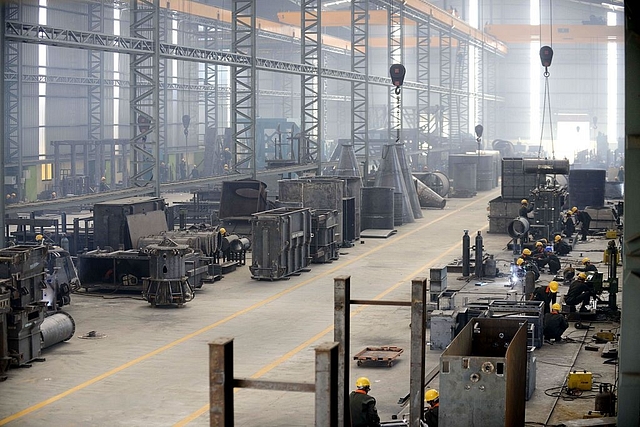
Eco Survey To Judiciary: Milords, If You’re Done Banning Crackers, Maybe You Could Speed Up Economic Cases
Indian courts and government litigants are stalling India’s ease of doing business by delaying economic cases.
It is time to move away from BCCI and Diwali crackers to more urgent issues concerning the exchequer and the taxpayer.
Milords, if you are done with all the judicial infighting, banning Diwali crackers and fixing the BCCI, maybe you could spend time reading the Economic Survey 2017-18. It holds a mirror to how courts – along with government litigants – are essentially ruining India’s ease of doing business by presiding over enormous delays in deciding economic cases.
Little wonder, even as India leapt from Rank 130 to 100 in the World Bank’s Doing Business report 2018, we were underperforming compared to the likes of Sudan and Congo in the enforcement of contracts, coming in at No 164 in a field of 191.
Not surprising, since the courts are more keen to decide how Indian cricket should be run, or what SUVs should be taxed, or whether IPL grounds should be watered in a year of drought rather than to look at “complex” cases involving economic litigation.
Even the creation of arbitration panels and appellate tribunals – which are supposed to decrease caseloads in high courts and the Supreme Court – has not helped. After studying six major appellate tribunals, the Survey discovered a “high pendency of cases”, with over 1.8 lakh cases…. Nearly every tribunal started with manageable caseloads, disposing instituted cases every year, but that soon spiralled out of control. Compared to 2012, there is now a 25 percent increase in the size of unresolved cases. The average age of pending cases across these tribunals is 3.8 years.”
Normally, the creation of appellate tribunals should reduce the burdens on the higher courts, but the opposite happened. The Survey, which looked at three sets of economic cases – dealing with companies, arbitration and taxation - pending with five high courts, found that the pendency was rising rather than falling. It notes: “While the volume of economic cases is smaller than other case categories, their average duration of pendency is arguably the worst of most cases, nearly 4.3 years for five major high courts. The average pendency of tax cases is particularly acute at nearly six years per case.”
What’s going wrong? One factor is clearly the high level of litigation launched by government departments themselves, even where the money involved is small. The Survey notes that as at the end of March 2017, “there were approximately 1,37,176 direct tax cases under consideration at the level of ITAT, high courts and the Supreme Court…(but) just 0.2 percent of these cases constituted nearly 56 percent of the total demand value; and 66 percent of pending cases, each less than Rs 10 lakhs in claim amount, added up to a mere 1.8 percent of the total locked-up value of pending cases.”
The conclusion is simple: if the government merely agrees to forgo claims of under Rs 10 lakh, or settles them by compromise out of court, pending cases will fall by two-thirds, and it will actually get better revenues since the courts can then focus on the cases which involve bigger sums.
It’s the same with indirect taxes. The Survey says that as in March 2017, “a total of 1.45 lakh appeals were pending with the Commissioner (Appeals), CESTAT, high courts and the Supreme Court together, that were valued by the department at Rs 2.62 lakh crores. Together, the claims for indirect and direct tax stuck in litigation…amounted to nearly 7.58 lakh crores, over 4.7 percent of GDP.”
But while one part of the answer lies with the government itself, where it needs to empower its own officers to settle minor cases without fear of vigilance enquiries, a large part of the blame lies with the courts themselves. More so when less than 30 percent of the cases are successful at the appellate, high court or Supreme Court levels.
The Survey, prepared under the supervision of Chief Economic Advisor Arvind Subramanian, makes no bones about the fact that both the high courts and the Supreme Court have been busy taking up special cases instead of dealing with crucial economic cases.
The Survey notes that the “increased overload is due to the expansion of discretionary jurisdictions by courts, without any countervailing measures that either balance the scope of other jurisdictions or improve overall administration and efficiency. For example, Articles 226 and 227 of the Constitution…. empower high courts with carefully circumscribed writ jurisdiction. In practice, however, the high courts have permissively and expansively interpreted this provision over a period of time, which has resulted in a substantial increase in Article 226 cases. There are currently one million writ petitions pending at the six high courts studied, constituting between 50-60 percent.”
Nor is the Supreme Court any less blameworthy in taking up special cases rather than regular ones. The Survey has this to say: “The Supreme Court, like the high courts, has less capacity to deal with mounting economic cases because of rising overall pendency. In the case of the SC, the burden derives in part from Special Leave Petitions under Article 136 of the Constitution…which empowers any party to approach the Supreme Court directly from any court or tribunal. Initially invoked only in ‘exceptional circumstances’, SLPs are now an overwhelming feature of practice at the Supreme Court. The rate at which the Supreme Court admits Special Leave Petitions under Article 136 of the Constitution increased from around 25 percent in 2008 to nearly 40 percent in 2016.”
The moot point is this: can we get better justice if the courts are too involved in hearing cases that grab media attention rather than focusing on “boring” bread-and-butter ones that are vital to the economy?
Milords, it is time to move away from BCCI and Diwali crackers to more urgent issues concerning the exchequer and the taxpayer.